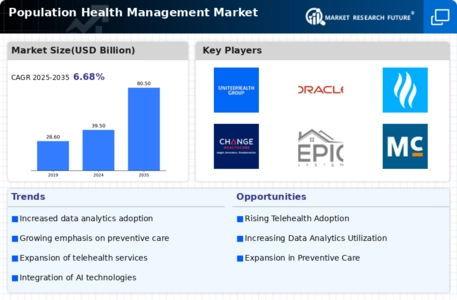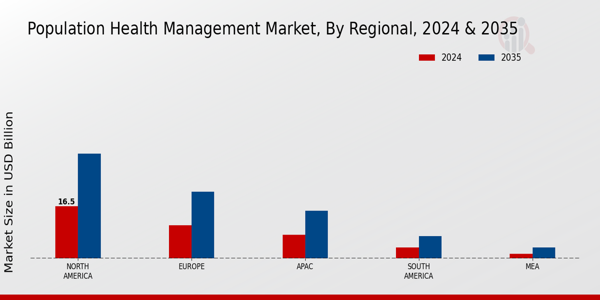Market Analysis
Population Health Management Market (Global, 2024)
Introduction
The population health management market is set to play a key role in the transformation of the health care system, driven by the increasing focus on value-based care and the need for improved health outcomes across diverse populations. The adoption of advanced analytics, data integration, and technology-driven solutions has become essential for health care organizations to improve patient engagement, optimize care delivery, and reduce costs. The population health management market comprises a wide range of tools and services to analyze health data, identify at-risk populations, and target interventions, enabling a more pro-active approach to managing health. The convergence of health care professionals, payers, and technology vendors is reshaping the market, as the complexity of chronic disease management, social determinants of health, and patient-centered care increases. The population health management market will evolve to meet the dynamic needs of health care systems and the populations they serve.
PESTLE Analysis
- Political
- The population health management market will be influenced by government initiatives to improve health care. The US government has allocated $1.5 billion for population health management. Also, the implementation of the Affordable Care Act will continue to influence the market, especially by encouraging the development of value-based care. Value-based care focuses on the prevention of disease and the management of chronic diseases.
- Economic
- Economic factors affecting the population health management market in 2024 are rising healthcare expenditures, which are expected to reach $4.3 trillion in the United States alone. This increase is due to the rising demand for health services and the need to manage costs. Also, the unemployment rate is expected to be around 3.8%, which will ensure a stable economy, which will allow more people to access health services and the tools needed for population health management.
- Social
- In 2024, the population’s awareness of health and well-being was at a high point. In the United States, 78 per cent of adults were seeking preventive care. This shift in consumer behaviour was generating a growing demand for population health management solutions that would address chronic diseases and promote healthier lifestyles. 54 million Americans were aged 65 or over. This was leading to a greater demand for health management solutions that could address their specific health needs.
- Technological
- In 2024, technological advancements will play a crucial role in the population health management market. Approximately seventy percent of hospitals will have adopted an EHR to enhance data sharing and patient engagement. Artificial intelligence and machine learning will be increasingly used in the health data analytics industry. The total investment in health technology is expected to reach $20 billion. These technological advancements will help health care organizations to gather and analyze population health data and to implement targeted interventions.
- Legal
- In 2024, the legal factors that will affect the population health management market are the implementation of data protection laws, such as the Health Insurance Portability and Accountability Act (HIPAA), which requires strict compliance with the handling of patient data. The Department of Health and Human Services has reported more than 300 violations of HIPAA regulations, demonstrating the importance of data security in population health management. Moreover, new laws to reduce health disparities are being introduced, which may require organizations to change their strategies.
- Environmental
- In the context of population health management, considerations of the environment are becoming increasingly relevant, especially given the growing importance of the social determinants of health. By 2024, about 40 per cent of health care institutions will have implemented programmes to address the effects of the environment on health, such as air quality and access to green spaces. In addition, the health care sector is under pressure to reduce its carbon footprint, with the aim of reducing its greenhouse gas emissions by 50 per cent by 2030. This could have an impact on population health management strategies.
Porter's Five Forces
- Threat of New Entrants
- In 2024, the threat of new entrants in the Population Health Management Market is moderate. There are significant barriers such as the regulatory framework, advanced technology, and existing relationships with healthcare professionals that can prevent new entrants from entering the market. However, the growing demand for health management solutions and technological developments are expected to encourage new players to enter the market.
- Bargaining Power of Suppliers
- The suppliers in the population health management market have relatively little power. The market is characterised by a large number of suppliers of technology and services, which dilutes the power of individual suppliers. Furthermore, many companies can change suppliers without major costs, which also weakens supplier power.
- Bargaining Power of Buyers
- The buyers in the population health management market have significant bargaining power. There are many suppliers, and this makes it possible to negotiate better prices and conditions. The increasing focus on cost efficiency and value-based care also gives the buyer the power to demand high-quality solutions at a competitive price.
- Threat of Substitutes
- The threat of substitutes in the population health management market is moderate. There are alternatives, such as traditional health management practices and emerging solutions, but the unique advantages of dedicated population health management solutions make them stand out. However, as technology evolves, the threat of substitutes will increase.
- Competitive Rivalry
- Competition in the market for population health management is intense. There are a large number of established players and newcomers competing for market share. The continuous innovation and improvement of the offerings to attract new clients is resulting in a very aggressive market. The competition is intensified by the rapid technological development and the growing demand for effective health management solutions.
SWOT Analysis
Strengths
- Growing emphasis on value-based care and patient outcomes.
- Integration of advanced analytics and AI for better decision-making.
- Increased government support and funding for population health initiatives.
Weaknesses
- High initial investment costs for technology implementation.
- Data privacy concerns and regulatory compliance challenges.
- Limited interoperability between different health IT systems.
Opportunities
- Expansion of telehealth services and remote patient monitoring.
- Rising demand for personalized medicine and targeted interventions.
- Potential for partnerships with tech companies to enhance data analytics capabilities.
Threats
- Intense competition from established healthcare IT companies.
- Rapid technological changes leading to obsolescence of current solutions.
- Economic downturns affecting healthcare budgets and spending.
Summary
The population health management market in 2024 is characterized by several positive trends, such as the focus on value-based care and advanced analytics, and by some negative trends, such as high costs and data privacy issues. Opportunities for growth include telehealth and precision medicine. Threats to the market include competition and economic factors. Strategic alliances and innovation will be important for stakeholders to navigate this evolving landscape.












Leave a Comment